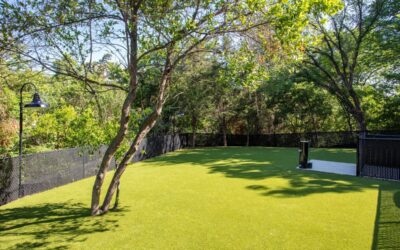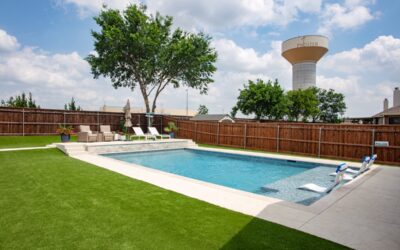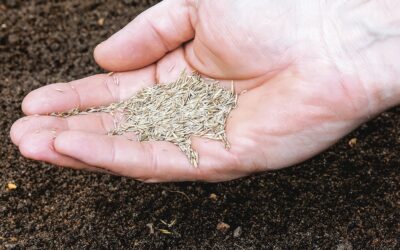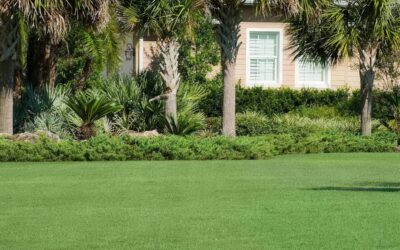One of the attractions of artificial grass is that it can be installed almost anywhere in the front or back yard—but only if the ground is prepared properly beforehand.
The base layer installed beneath the grass surface should be flat and level. The turf can be installed on a slope but artificial grass will quickly look unsightly and flawed if it is installed on top of an uneven surface.
Understanding a little more about the installation process for artificial grass and what can happen if it is laid without correct ground preparation should convince home and business owners to seek the help of professional synthetic grass installers to manage the process from start to finish…
Can you install artificial grass on uneven ground in your yard?

It’s a bad idea to lay artificial grass on uneven or ungraded ground. But synthetic turf can be installed on non-level areas (slopes) or, in fact, practically any area of your front or back yard if the ground preparation is right.
Installation is no DIY job—unless you have considerable landscaping or grading experience. Such installations generally require professional landscapers.
To prevent unsightly “kinks” in the turf, the ground beneath the grass will need to be rolled and flattened until it presents a perfectly even surface for the grass to be laid on and adhere to. You may not need a putting green-like surface but even high-quality artificial grass lawns will suffer if the ground beneath hasn’t been prepared properly.
The problems are not just aesthetic—though these are the most obvious ones. Safety and health are important considerations, especially when your family uses the artificial grass areas for activities like picnics, play or sports.
The more uneven areas there are on your grass, the more slips, trips, and falls are likely—so, backyard lawns, kids’ play areas, sports fields and so on should all be installed to a high standard with professional help.
We’ll take a look at all the potential problems that can arise with uneven surfaces soon but first, let’s consider the installation process for artificial grass.

How to lay artificial grass on uneven ground
You don’t need to spend your own time leveling the ground for synthetic turf installations. That’s considered part of the job by the artificial grass professionals at DFW Turf Solutions.
We’ve handled thousands of installations in Texas and here’s how we go about preparing the ground before we even think about unrolling any turf:
Remove existing topsoil and vegetation
The first step is to remove any obvious obstacles to a flat surface, stripping away the sod and the first few inches of topsoil along with any weeds, bushes, rocks, etc.
We need the soil as pure and flat as possible because this will act as the very base of the installation. It’s best to let the ground dry after any rain before attempting this step.
We may need to add some topsoil to the remaining soil but this is optional. Then, we flatten and compact the soil as required.

Create a drainage system
If drainage is poor, we’ll create a drainage system by leaving a small drainage gap every 15 cm around the perimeter of the proposed installation.
The best artificial turf is highly permeable and stands up well to heavy rains but if the soil below it impedes drainage, you’ll soon start to notice problems. During the preparation for installation, therefore, we ensure that water can drain away from the grass surface to prevent “pooling” after heavy rains.
Install a waterproof barrier along the perimeter
A short plastic bender board or a block of concrete is usually installed around the perimeter of the installation to prevent the garden from splitting or slumping over time —but this shouldn’t protrude above grass level.
Add a flattened rock/base layer
Once the soil area is flat, the base layer is ready to be installed. This is a layer of shale, which is finely ground rock, decomposed granite, and gravel (particles under ⅜ inch and a depth of 3-4 inches is best).
The base layer should be made level on top of the soil by using a flattening tool or roller.

Dampen and compact the surface
It’s not enough for the base layer to be flat—it should also be well-compacted to ensure that it is stable and doesn’t move around under the grass.
We will sprinkle water on the gravel or sand from the garden hose and then compact the material until it’s firm and relatively solid. For this, we’ll use a roller compactor, plate compactor or hand tamp. Around 90 percent compaction is generally advisable.
Installing your artificial grass
With these steps, almost any piece of ground can be prepared for an artificial grass installation. For additional peace of mind, we may apply weedkiller before cutting and laying the artificial grass, to ensure that no unwanted vegetation crops up.
The grass should be professionally cut and secured for a seamless finish and to stop it from “moving” over time.
If you install your grass on more than a 2-3 percent slope, some additional precautions will be required during the installation process to prevent the grass from slipping but these are complications that our installation team is well-accustomed to handling.

Tools required to create an even base layer beneath artificial grass
Following is a quick list of tools required for preparing the ground for a professional artificial grass installation. As you can see, some of the tools required are not standardly found in garden sheds:
- Measuring tape
- Sod cutter (optional)
- Shovel and rake
- Wheelbarrow
- Ground tiller (optional)
- Topsoil
- Rock/base
- Lawn roller
- Compactor (hand or automatic)
- Water/hose
Generally, for large yards or surfaces with many large holes requiring considerable grading work, professional grading and compacting equipment are preferable to standard garden tools.

What happens if you install artificial turf on uneven ground?
Laying artificial turf on uneven ground that has not been properly prepared can lead to a host of problems in multiple areas.
Aesthetics
The most obvious issue is the unsightly and flawed appearance of the grass area. Every bump and divot tends to stand out on artificial grass surfaces that are not laid professionally.
Wrinkles, kinks, lifting, slumps or bubbles/blisters on the surface make it obvious that the area is synthetic grass. The best artificial grass closely resembles natural grass and some installations are barely distinguishable from the real thing—but not if there are many imperfections on the surface.

A poorly graded area of soil beneath the grass also increases the risk of uneven joints and unsecured edges to the grass area. A lack of ground preparation can also cause tears in the artificial grass surface or the backing from rocks or sharp stones. These can be expensive to repair or replace and, again, greatly impact the aesthetics of the area.
Another way that uneven ground can affect an artificial grass lawn is by impeding the weed barrier beneath (if used). This could lead to more weeds pushing through, especially at the seams.
Correcting imperfections on an artificial grass surface is not easy. Complete removal of the installation and a fresh start is usually required. It’s much easier to prepare the ground properly from the beginning!
Usability
Drainage problems caused by poorly prepared ground can also lead to pooling water on the surface of the grass after heavy rains.
One of the advantages of artificial grass over real grass is that it remains usable all year round because there’s no mud, mess or waterlogging to contend with. Kids and pets can play soon after rainfall.
However, poor drainage due to a lack of ground preparation will make the area less usable and cause “downtime” from pools of water on the surface.

Safety
Laying artificial grass on uneven ground will increase the likelihood of divots and other trip hazards developing in the grass area. This is especially dangerous when using artificial grass for children’s playground flooring or sports fields.
Special care must be taken when preparing these areas because shock-absorbent underpadding is required to prevent fall injuries.

Shock absorbers cushion the impact of falls, so simply rolling out turf on an uneven surface is asking for trouble. These areas require professional installations.
Health
Even your family’s health can be impacted if you try to install turf on top of uneven, improperly prepared ground.
Pooled water can lead to mold, mildew, odors, bacteria traps, and other nasties that you don’t want on an artificial lawn.
Lifespan and cost of ownership
The main cost benefits of artificial grass come from its longevity and low maintenance requirements. After five or six years, high-quality, professionally installed artificial grass will pay for itself when compared to real grass.
If your turf is not installed properly on even, flat ground, these cost benefits may disappear or at least be reduced.

Ready to switch to artificial grass?
By switching to artificial grass, you can look forward to minimal maintenance and cost savings over time, as well as a lawn that lasts for decades and looks perfectly green and pristine all year round.
But you don’t simply buy turf from the DIY store and roll it out. Laying artificial grass directly on unprepared soil will lead to visible flaws, poor performance and usability, and health and safety risks for you and your family.
Let our team look after your installation and deliver the grass area you expect. Talk to an artificial grass professional at DFW Turf Solutions to discuss your options.






